The Importance of Large Bird Cages for Pet Birds
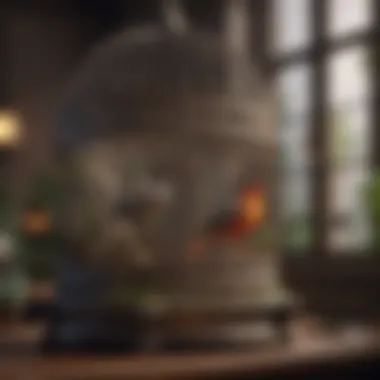
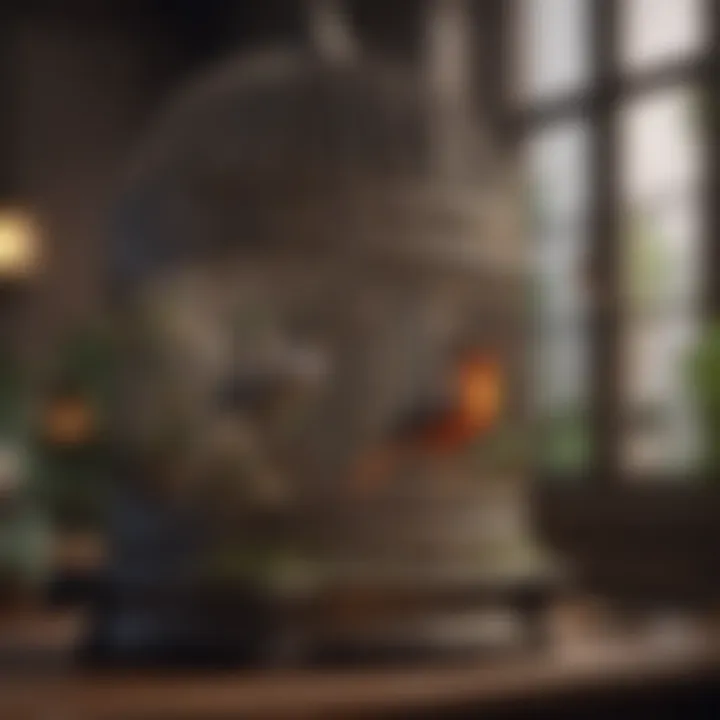
Intro
The world of pet birds is not just limited to chirps and flutters; it’s a vibrant tapestry woven with the needs, quirks, and personalities of these feathered companions. When it comes to ensuring their happiest living arrangements, bird cages take center stage. However, this isn’t just about a basic enclosure—very large bird cages open up a realm of possibilities that dramatically influence the lives of our pet birds. They serve as sanctuaries where our avian friends can thrive, explore, and express their natural behaviors.
But what makes these large structures so vital? For starters, the design of a bird cage plays a crucial role in its functionality. The dimensions, materials, and even the layout can significantly affect the well-being of different species. Each bird has unique needs, and understanding those is key in providing a setting that promotes good health and happiness.
The article unfolds a comprehensive guide that will touch on various aspects. We'll discuss not just the aesthetics of these cages but also how to care for them, the behavioral insights that inform fence design, and everything from nutrition to wellness. By thoroughly exploring these topics, bird owners will be equipped with the knowledge necessary to create optimal environments for their feathered companions. Let’s dive in to discover how very large bird cages can transform the lives of pet birds, enhancing both their quality of life and our joy in their presence.
Prologue to Avian Environments
When you step into the world of bird ownership, understanding avian environments takes center stage. An appropriate environment is more than just four walls; it embodies the essence of freedom, safety, and comfort for your feathered companions. Bird behavior can often be perplexing. Knowing what birds need will streamline your experience and create a homey setting that enhances their well-being.
Birds are natural explorers. They thrive when given space to spread their wings, both literally and figuratively. The design and dimensions of cages play a significant role here. Remember, a small aviary-like structure might feel restrictive to a parrot, while smaller, nimble species like canaries may require less room. It’s crucial to ensure that the cage you choose suits not just the functionality you seek but also mirrors the natural habitats of your birds.
Understanding Bird Behavior
Bird behavior is one of those fascinating topics that ties directly into how we manage their spaces. Birds are social creatures, often forming bonds with their human caregivers. This behavior can lead to various outcomes in how they react to their environments. For instance, an overly secluded area may instigate stress in a social bird, while adequate stimulation, such as interactive toys and perches, fosters a sense of security.
Observing their behaviors, such as the way they perch or interact with their surroundings, is valuable for understanding what they need. There are numerous elements to consider:
- Socialization with people and other birds
- The need for mental stimulation
- Physical activities like climbing and flying
Engaging with birds and responding proactively to their signals can lead to a richer experience for both birds and their owners alike.
The Importance of Space
Space is not just luxury; it serves as the very foundation for a bird's happiness. A cramped environment frequently leads to unnecessary stress and undesirable behaviors such as feather plucking or aggressive tendencies. Factors that can help in determining the proper space include:
- Species size: Larger birds unmistakably require significantly more space than smaller breeds.
- Activity level: High-energy birds, like cockatoos, need room to flap their wings and play; restricting them can lead to frustration.
- Multiple birds: In homes where birds share real estate, understanding their social hierarchies is imperative. Too little room can lead to rivalry.
To sum it up, the size and arrangement of your bird's environment dramatically affect their mood and health. When investing in avian structures, always keep in mind that a few extra inches can make a world of difference.
"A happy bird is a healthy bird."
Ultimately, taking the time to build a well-suited living area can transform the quality of life for these avian friends.
In the upcoming sections, we will delve into more specific aspects of large bird cages, ensuring that you have all the insights needed to enrich your pet's world.
Characteristics of Very Large Bird Cages
When considering the welfare of pet birds, the characteristics of a large bird cage cannot be overlooked. Large cages are more than just an enclosure; they play a pivotal role in a bird’s physical and mental well-being. Understanding the traits that define these cages helps owners create not just a home but a sanctuary for their feathered friends.
Dimensions and Scale
In the realm of avian husbandry, size matters. The dimensions of large bird cages must accommodate a bird's natural behaviors, such as flying, climbing, and playing. A cage that is too small can lead to a host of issues, including stress, feather plucking, and even health problems. Ideally, a large cage should be spacious enough for the bird to stretch its wings, climb vertically, and engage in activities that mimic life in the wild.
Different species have unique scaling needs. For example, a macaw, known for its playful antics and large wing span, would require a cage measuring at least 6 feet high by 4 feet wide, whereas a budgerigar might thrive in a somewhat smaller habitation. The recommended dimensions can vary, but ensuring adequate space is essential.
Additionally, the depth of the cage should not be dismissed. A rectangular design facilitates movement and exercise, promoting better overall health. A wider cage allows multiple perches and toys, reducing boredom.
Materials and Construction
Selecting the right materials for a very large bird cage is crucial for both durability and safety. Common materials used include non-toxic metals, such as stainless steel or powder-coated finishes, which withstand wear and tear. It's important to avoid cages that are made with materials that can be toxic to birds.
Furthermore, the construction of the cage should be robust, with bars spaced appropriately to prevent any escapades. For instance, medium-sized birds like greys require a bar spacing of about 0.5 to 0.75 inches to keep them secure. A well-built cage not only protects the bird but also ensures peace of mind for the owner.
Wooden components, like perches and play tops, should be sourced from non-toxic trees, like manzanita or birch, to ensure safety if the birds choose to chew. Proper ventilation is also a key feature which encourages airflow, helping to keep the environment fresh and minimizing the risk of respiratory issues.
Design Aesthetics
While functionality is paramount, design aesthetics shouldn't be swept under the rug. A very large bird cage should blend seamlessly into the home environment, turning an ordinary space into an eye-catching feature. Cages come in various styles, from rustic wooden frames to sleek modern designs, allowing owners to choose one that complements their decor.
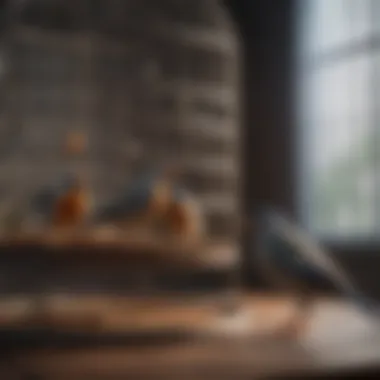
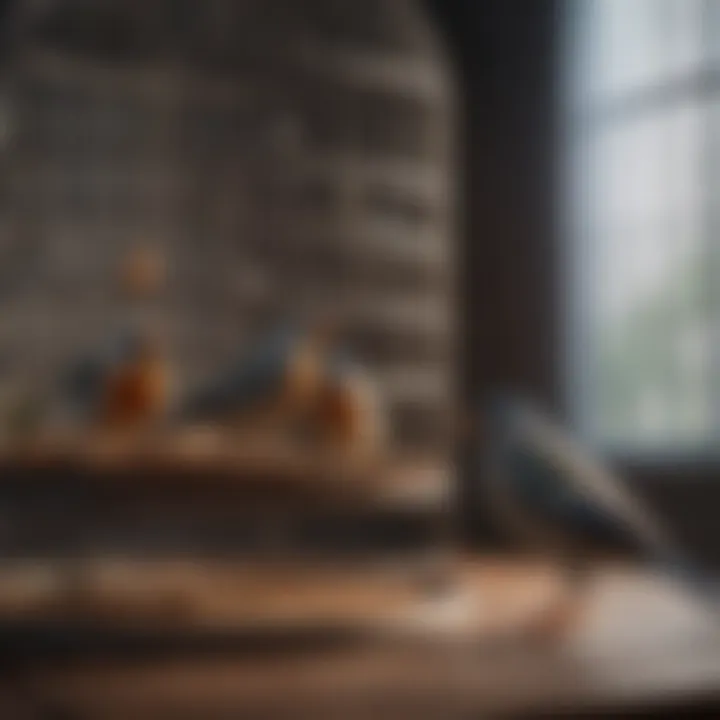
"A well-designed cage doesn’t only house its occupants; it celebrates their vibrancy and charm."
The position of the perches, toys, and food stations should also be considered in relation to the cage design. A well-laid-out environment encourages natural behaviors and provides an enriching habitat. Visual elements like bright colors can stimulate curiosity, while subtle designs can be calming.
Moreover, consider opting for accessories that match the cage style. This attention to detail not only creates a harmonious appearance but also enhances the living experience for the birds. An aesthetically pleasing cage reflects the owner’s care and respect for their pets, making it an inviting space.
Species-Specific Needs
When it comes to the well-being of pet birds, understanding species-specific needs is paramount. Each species has unique traits and behaviors that demand thoughtful consideration when creating their living environments. Catered spaces not only promote physical well-being but also foster mental stimulation, encouraging an enriched life for your feathered companions. From food preferences to space requirements, a deep dive into these elements can make all the difference in keeping your avian friends happy and healthy.
Parrots and Their Requirements
Parrots are clever creatures. They require more than just a large cage; their environments should be rich in stimulation. One vital need is mental engagement. Parrots thrive on interaction and toys that challenge their intelligence. Consider providing foraging toys, which entice them to search for treats within their cage. These toys help to prevent boredom, a common issue among parrots.
Social interaction with humans and other birds is also crucial. Parrots are naturally social animals, so a single parrot in isolation can feel lonely. Hence, it might help to place the cage in a bustling part of your home, where they can be part of your daily activities, without being directly crowded. Moreover, size matters; a spacious cage allows them to stretch their wings freely and engage in climbing.
While every bird thrives in a well-designed space, parrots particularly benefit from an environment tailored to encourage both physical activity and socialization.
Canaries and Finches
Canaries and finches are more petite than parrots, but their needs are no less important. They often prefer a quieter, calmer environment compared to the boisterous personality of parrots. Canaries, for instance, need a setup that allows for flitting and singing, as these activities are part of their natural behavior. A long and narrow cage is often preferable for their flight patterns, which is quite different from the wider cages required for larger birds.
Finches thrive in small flocks. Having a few companions can promote happier living conditions. When setting up their cage, consider adding perches at varying heights and providing a variety of plants. This can mimic their natural habitat, where they would typically flit among branches. Use fresh fruits and vegetables for their diet during the week; their taste for variety also encourages a healthier lifestyle.
Additional Species Considerations
The avian world is populated with various species, each with its own quirks and necessities. Assessing additional species can add depth to your understanding of bird care. For example,. smaller birds like budgies also require social interaction but need more space to fly than canaries—likely because of their energetic nature. Also, larger species such as macaws have specific dietary needs that include a high-fat diet along with protein and vitamins.
Understanding species like cockatiels or lovebirds, who cherish companionship, can similarly affect how you construct their cages. Each type of bird provides certain clues about its requirements from their behaviors. Observing these nuances can not only deepen your affinity for your feathered friends but also ensure they lead fulfilling lives within their very large cages.
Placement of Bird Cages in Home Settings
The positioning of bird cages in your home is not merely a matter of convenience; it's about ensuring health, safety, and comfort for your feathered companions. Choosing the right location can significantly impact the wellbeing of your birds, offering them a blend of stimulation and tranquility. It's a vital aspect often overlooked by new pet bird owners, yet it lays the foundation for a harmonious living arrangement.
Indoor vs. Outdoor Locations
When contemplating where to place a bird cage, one of the first decisions to make is whether to keep it indoors or outdoors. Each option comes with its unique sets of advantages and challenges.
- Indoor Benefits :
- Outdoor Considerations:
- Controlled Environment: Keeping the bird cage indoors protects your birds from unpredictable weather elements like extreme heat, cold, or wind.
- Safety from Predators: Indoor placements shield your birds from predators such as cats or hawks, ensuring they are safe from harm.
- Human Interaction: Birds are social creatures. An indoor setting can facilitate more interactions with family members, fostering companionship and reducing social isolation.
- Fresh Air and Natural Sounds: An outdoor cage can immerse your birds in nature, allowing them to experience fresh air and enjoy the lovely sounds of the outdoors.
- Sunlight Exposure: If well placed, outdoor cages can provide essential sunlight, which can be beneficial for the birds’ health. However, too much exposure needs caution to prevent overheating.
- Seasonal Changes: Placing cages outside might mean dealing with seasonal variations. Birds may need retreating indoors during storms or colder seasons.
Overall, the ideal location will depend on your local climate, the specific species of your birds, and your lifestyle. Careful consideration and flexibility will go a long way in ensuring a delightful habitat for your feathered friends.
Maximizing Natural Light
Birds thrive in environments enriched with natural light, which plays a crucial role in their health and happiness. Maximizing exposure to sunlight can enhance their mood, boost their immune system, and even promote healthier plumage. However, it must be balanced with protection from excessive heat and glare.
Here are some strategies to harness natural light:
- Window Placement: Positioning the bird cage near a window can provide ample light. Just be sure that direct sunlight does not make the cage overheated. Setting it slightly back from the window can still allow light in while preventing direct UV rays from scorching their feathers.
- Light Shelves: Consider using light shelves or sheer curtains to distribute light more evenly while providing a soft glow within the cage. Such measures ensure that the light is diffused, reducing harsh spots.
- Rotate Cage Location: Birds are observant and curious. Rotate their cage periodically, exposing them to various light angles and scenery. It not only maximizes light exposure but also stimulates their minds by providing new views.
Now, the practical aspect of using light for your birds: ensure they always have access to shaded areas where they can escape if they feel too warm. An environment where light and comfort coexist is the key to your birds thriving.
Important Note: Always monitor your birds for signs of stress or fatigue especially if they are subjected to changes in their environment.
Health and Safety Considerations
In the world of avian care, health and safety considerations can't be brushed aside. They are fundamental not only for the well-being of our feathered friends but also for fostering an enriched life within their cages. The right environment plays a significant role in preventing stress, keeping injury at bay, and ensuring that bird escapes become a thing of the past. Let's delve deeper into these aspects, which can make or break the experience of being a bird owner.
Reducing Stress for Birds
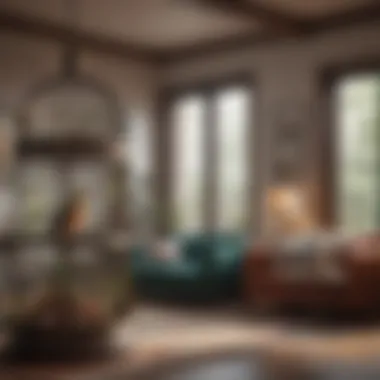
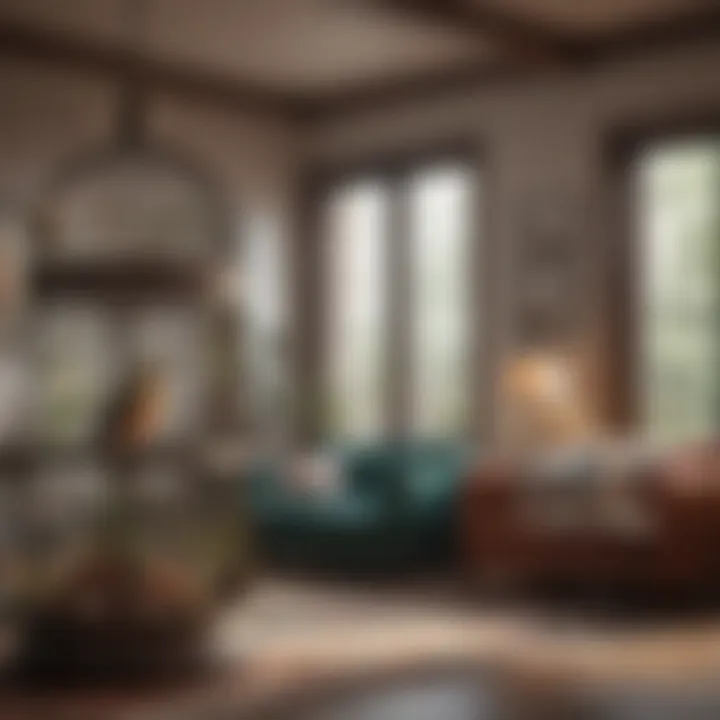
Birds, much like humans, can be prone to stress, and multiple factors can contribute to it. One vital element is ensuring that their living space is appropriate in size and design. A very large bird cage offers ample room for movement, which helps them stretch their wings and roam freely, directly impacting their comfort level.
- Environmental Enrichment: Adding perches at varying heights and creating a stimulating environment with toys can drastically reduce anxiety. Birds thrive in spaces where they feel safe yet curious.
- Social Interaction: As social creatures, many birds benefit from interaction—not only with other birds but also with their human companions. Regular interaction can significantly ease their worries and contribute to their mental health.
- Sound Management: Birds are sensitive to sounds, and loud noises can be unsettling. Positioning the cage in a quieter part of the home can mitigate anxiety, allowing them to relax.
"Creating a calm atmosphere, both visually and acoustically, is key to reducing stress for your birds."
Preventing Injury and Escapes
One cannot discuss health and safety without touching on the crucial topic of preventing injury and escapes. Birds are adventurers at heart, but if their space isn't secure, they might end up in precarious situations. Here’s a rundown of strategies to minimize risks:
- Secure Cage Construction: When investing in a large bird cage, it is imperative to choose one that is built sturdy. Examine bars for gaps and ensure the door latches well. Keep a sharp eye on sharp edges that could harm curious beaks or limbs.
- Avoiding Hazards: Items within the cage, such as perches, toys, and food dishes, should not pose a danger. Always check for loose strings, paint that isn’t non-toxic, or small parts that could be ingested.
- Escape Routes: You want to make certain that the cage isn't just a fortress but also a place where the birds can’t inadvertently escape. Regularly check that all fixtures, such as food bowls, are secure to prevent accidental openings.
Maintenance and Care of Large Bird Cages
When it comes to ensuring the well-being of our feathered friends, there’s no shortcut; maintenance and care of large bird cages is paramount. A well-kept cage does more than just house a bird; it fosters a healthy environment that can impact your bird's behavior, hygiene, and overall happiness. Regular maintenance isn’t merely a chore—it’s an essential aspect of responsible birdkeeping that promotes a thriving life for your pets.
Cleaning Protocols
Cleaning a bird cage is not an endeavor to be taken lightly, and it requires an efficient approach to keep everything spick and span. The frequency of cleaning depends on various factors including the size of the cage, the number of birds, and their overall activity levels. Here are some crucial pointers to establish a solid cleaning protocol:
- Daily Upkeep: Start with a quick sweep of the cage every day. Remove soiled papers, leftover food, and any droppings. A daily inspection helps to identify any potential issues before they escalate.
- Weekly Deep Clean: Give your bird’s home a thorough scrubbing at least once a week. This involves removing toys, perches, and food dishes to clean them separately. A solution of warm water and mild soap can be effective; however, be sure to rinse well to avoid residue. Bleach can be used for deeper disinfecting but make sure it’s heavily diluted and well-rinsed afterward.
- Regular Replacement of Linings: Swap out the lining on the bottom of the cage frequently. Good options include newspaper or specially designed cage liners. They’re cheap and does a splendid job at absorbing moisture and odors.
Important: Always allow your cleaning supplies to dry completely before returning items to the cage. Moisture can lead to mold growth, which is particularly harmful to birds.
Regular Inspections
Keeping an eye on your large bird cage goes beyond just cleaning; regular inspections are a linchpin in ensuring the safety and comfort of your avian companions. Small unnoticed damages can become a big headache. Here are some pointers to help with your inspection routines:
- Cage Integrity Check: Examine the structure of the cage regularly for any signs of wear or tear. Look for rust, frayed wires, or loose hinges. Taking care of these issues early can save a lot of trouble in the long run.
- Bedding and Toys: Regularly inspect perches, toys, and bedding materials for signs of deterioration. Birds are naturally curious, and damaged items can pose choking hazards or injury.
- Health Indicators: During your inspection, observe your birds’ behavior closely. Any changes in energy levels, eating habits, or general demeanor can be an indication of underlying health issues. If something seems off, a vet visit might be in order.
By establishing a routine for cleaning and inspections, bird owners can cultivate an environment that not only looks appealing but is safe and healthy for their pets. Taking these proactive steps is key in nurturing a fulfilling life for our avian companions.
Enhancing Bird Cages for Enrichment
Creating an enriching environment for pet birds goes beyond just providing a spacious cage and clean water. Enhancing bird cages for enrichment is crucial in ensuring the physical and mental health of our feathered companions. Birds are naturally curious creatures, and boredom can lead to stress, feather plucking, and other behavioral issues. Thus, it’s important that bird owners take steps to incorporate engaging elements into their cages. This section will explore two significant aspects: the toys and activities that keep birds occupied, and the dietary elements that further support their well-being.
Toys and Activities
Birds, whether they are playful parrots or inquisitive finches, thrive on stimulation. Incorporating toys and activities in their cages is essential for preventing boredom. Here are some practical suggestions for choosing toys:
- Variety is the Spice of Life: Rotate toys every few weeks to keep interests piqued. A toy that seems fresh one day can feel stale the next. Consider different types, such as foraging toys, chew toys, and those that produce sounds.
- Interactive Play: Birds love to engage with their toys. Opt for ones that require them to come up with strategies, like puzzle feeders that dispense treats when solved. This encourages problem-solving and mimics their natural instincts.
- Crafting a Play Area: If the space allows, set up a play gym nearby, incorporating swings and perches. Birds can enjoy supervised exercise time outside their cage, promoting physical health.
- Safety First: Avoid toys made from toxic materials or that have small parts that might pose choking hazards. Always inspect for wear and tear since birds can be quite determined when it comes to destroying their playthings.
"An engaging environment reflects the heart of potential bird ownership. A thriving bird is a happy bird."
Diet and Nutrition
The second facet of enrichment touches on diet and nutrition. A well-rounded diet not only supports the physical health of birds but also engages them mentally. Here’s how to effectively enhance their meals:
- Diverse Diet Composition: A balanced diet goes beyond seeds. Incorporate pellets, fresh fruits, and veggies, as well as occasional nuts or grains. Each food type provides different nutrients essential for their overall well-being.
- Experiment with Presentation: Why not turn meal times into an activity? Instead of simply placing food in bowls, consider hanging veggies or scattering seeds around the cage. This mimics foraging behaviors and keeps them sharp.
- Hydration Matters: Fresh water is non-negotiable. Consider adding a small water fountain that encourages them to drink more frequently.
- Supplements Wisely: Bird owners may also want to look into supplements, particularly for species with specific dietary needs. Consult with an avian veterinarian to find the right approach tailored to the bird's age and health status.
In summary, creating an enriching environment within very large bird cages is a multi-faceted endeavor. Providing toys and nutritious food isn't merely an obligation; it's a way to express love and commitment toward our avian companions. Embracing these practices fosters a happier, healthier life for pet birds, ensuring they never fly into the blues, even while in their spacious homes.
Costs and Investment in Large Cages
When embarking on the journey of procuring a very large bird cage, one must recognize the significance of budgeting and investment. This consideration transcends mere spending; it’s about ensuring the well-being and happiness of your feathered companions.
Large bird cages can be quite an investment, not just in terms of initial costs, but also in the ongoing expenses related to the birds' quality of life. Understanding these financial implications can help pet bird owners make more informed decisions.
Budgeting for Quality
In the realm of bird care, the mantra often echoed is "you get what you pay for." When assessing large bird cages, striking a balance between affordability and quality is paramount. Here’s why:
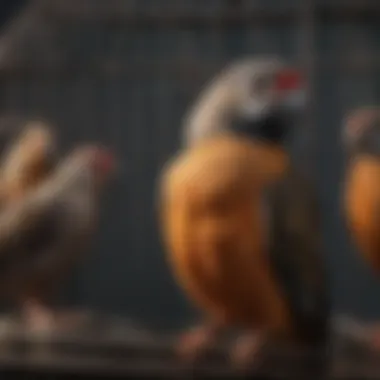

- Durability: Investing in a well-made cage means fewer repairs and replacements down the line. A sturdy metal structure may cost more upfront but save money in the long run.
- Safety Features: Quality cages come equipped with non-toxic materials and safe designs, preventing potential hazards to your birds.
- Space Efficiency: A larger cage allows for more productive use of space, accommodating various toys and accessories that enrich your birds’ lives.
To make a solid budget, owners should consider what’s practical rather than what’s just appealing. It’s beneficial to set a realistic budget, allowing for adjustments as needed. Use the following framework:
- Determine your maximum expenditure on the cage.
- Identify additional expenses (accessories, food, toys).
- Factor in recurring costs like maintenance and health care.
Make sure you allocate enough funds for quality to avoid pitfalls from hidden costs later.
Long-term Financial Considerations
The financial discussion doesn't stop at the purchase of the cage. Various long-term considerations can influence your overall investment. Certain aspects are often overlooked during the initial buy:
- Maintenance Costs: Regular upkeep like cleaning, repairs, and replacements of worn parts are often inevitable.
- Accessories and Enrichment: Birds thrive in environments rich with various items. Toys, perches, and food are recurring expenses that should fit into your budget.
- Health Care: Vet visits and potential health issues, especially in larger breeds like macaws or cockatoos, can accumulate significant costs over time.
Thus, planning for these ongoing expenses is crucial. A good approach is to create a yearly spending plan that incorporates all these aspects, allowing for a clearer picture of what taking care of your avian companions entails.
Ultimately, having a financial game plan makes you a more responsible bird owner. This foresight ensures your home remains a safe and enjoyable space for your birds, creating a sanctuary tailored to their needs.
By meticulously analyzing all financial aspects, from initial outlay to continued care, bird owners can engage more deeply in their pet’s lives, offering a nurturing environment that ensures happiness and health.
Community and Manufacturer Resources
Navigating the world of very large bird cages can be akin to finding your way through a dense forest—challenging without a good map. This is where the role of community and manufacturer resources fills an essential gap. These resources not only serve as a guiding light for bird owners but are also platforms for sharing invaluable insights, experiences, and recommendations. From discovering trusted manufacturers to connecting with other bird lovers, these resources foster an environment that benefits both the birds and their caregivers.
In a realm often governed by personal preferences and pet species, having a veritable toolbox—from well-tested products to engaging communities—can turn the daunting task of choosing the right cage into a smoother journey. Owners can leverage these collective knowledge bases to formulate informed decisions that enhance the well-being of their pets.
Recommendations for Trusted Brands
When it comes to selecting a bird cage, not all brands are created equal. The importance of researching and choosing trusted brands can't be overstated. Quality matters—especially for very large bird cages. Some brands have cultivated a reputation over years for prioritizing safety, durability, and design efficiency. Some examples to consider include:
- BIRDY BUDDY: Known for their spacious designs tailored for larger birds. They often incorporate safety features like rounded edges and non-toxic materials.
- AVIAN ADVENTURES: Their cages not only boast ample space but also include enrichment toys that enhance the livability of the environment.
- NATURES EDEN: Offers eco-friendly options made from sustainable materials, emphasizing both aesthetic appeal and functionality.
These brands are praised for consistent quality and innovation. It’s advisable to read user reviews and consult community resources like forums or social media groups to vet these recommendations further. Pet bird owners often share their firsthand experiences, enabling others to make well-informed choices.
Joining Bird Owner Communities
Engagement within bird owner communities opens up a treasure trove of resources and companionship. Forums on platforms like Reddit or Facebook provide spaces for bird enthusiasts to discuss everything from cage aesthetics to health tips. Joining these communities helps owners find their niche, share challenges, and celebrate the joys of bird ownership.
Benefits of participating in such communities include:
- Knowledge Sharing: Gain insights into the unique needs of different bird species and how to cater to them effectively.
- Support Networks: Connect with fellow bird lovers who understand the complexities of pet care. These relationships often turn into valuable support systems.
- Product Recommendations: Members frequently discuss their own experiences with various products, including bird cages, helping you to sift through what works and what doesn’t.
Communities often organize local meetups or online events, creating opportunities for deeper friendships and shared learning experiences. As you immerse yourself in these networks, remember to contribute and share your perspective. In doing so, you are not only helping others but enriching the very community you belong to.
"Connecting with fellow bird owners provides a sense of belonging and encourages the sharing of knowledge that elevates the care for our feathered friends."
Future Trends in Large Bird Cages
As we step into a future increasingly shaped by sustainability and innovation, the realm of large bird cages is no exception. Understanding these trends is vital for pet owners, breeders, and all those who cherish avian life. The evolution of large bird cages not only reflects changing aesthetics but also a deeper comprehension of our feathered friends' needs. This section sheds light on two major trends: the use of sustainable materials and innovative design techniques aimed at enhancing bird comfort.
Sustainable Materials and Practices
The push for sustainability is more than just a trend; it's a necessary shift towards protecting our environment while catering to the needs of our pets. When considering very large bird cages, focusing on sustainable materials benefits both the planet and the well-being of our avian companions.
- Eco-Friendly Materials: Many manufacturers are opting for natural, renewable materials such as bamboo or recycled metals. These elements not only reduce waste but also provide a sturdy and safe environment for birds.
- Non-Toxic Finishes: It's essential to ensure that any coatings or finishes applied to a cage are free from harmful chemicals. This commitment to safety is gaining traction, resulting in more products designed with bird health at the forefront.
- Energy-Efficient Designs: Innovations also extend to manufacturing processes. Companies are looking at reducing their carbon footprints through energy-efficient production methods, leading to a lower environmental impact.
The benefits of embracing sustainability in bird cage design are manifold. Not only do sustainable cages minimize ecological harm, but they also foster a healthier environment for birds, contributing to their overall happiness and well-being.
Innovative Designs for Avian Comfort
As we look ahead, innovative design is poised to redefine the concept of bird cages. Gone are the days of simple, utilitarian structures. Today’s designs prioritize comfort and enrichment for our avian friends. Let’s consider some cutting-edge trends:
- Smart Bird Cages: The integration of technology is becoming prevalent. Smart cages, equipped with features like temperature control, humidity monitoring, and even built-in cameras, allow owners to keep a watchful eye on their pets.
- Multifunctional Spaces: Designers are creating cages with versatile uses in mind. Some large cages now include areas for nesting, perching, and even feeding, catering to the natural behaviors of different bird species.
- Ergonomic Features: Comfort is key. Designs are shifting towards ergonomically friendly spaces that minimize stress and encourage physical activity. Features such as varying perching levels, ramps, and hammocks are being incorporated to mimic natural habitats.
In essence, these innovative designs reflect a growing acknowledgment of the complex needs of pet birds. As bird owners become more educated on the requirements for companionship, manufacturers are responding with solutions that cater to health, activity, and overall comfort of their birds. This interaction creates a virtuous cycle whereby advancing technology and thoughtful design foster a better living experience for our avian friends.
"The future of bird cages lies not just in aesthetics, but in creating holistic environments that nurture the mind and body of our feathered companions."
In summary, keeping an eye on future trends in large bird cages helps avian enthusiasts make informed decisions. By understanding and embracing sustainable practices while recognizing how innovative designs can enhance avian comfort, we are stepping toward a more conscientious way of caring for our feathered friends.















